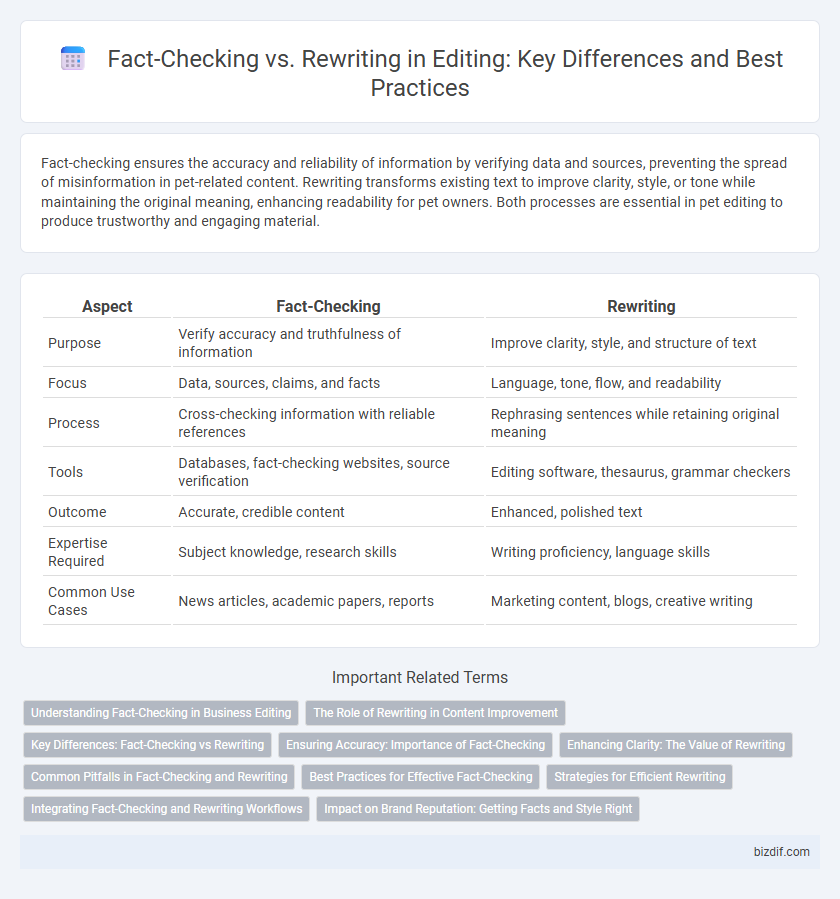Fact-checking ensures the accuracy and reliability of information by verifying data and sources, preventing the spread of misinformation in pet-related content. Rewriting transforms existing text to improve clarity, style, or tone while maintaining the original meaning, enhancing readability for pet owners. Both processes are essential in pet editing to produce trustworthy and engaging material.
Table of Comparison
| Aspect | Fact-Checking | Rewriting |
|---|---|---|
| Purpose | Verify accuracy and truthfulness of information | Improve clarity, style, and structure of text |
| Focus | Data, sources, claims, and facts | Language, tone, flow, and readability |
| Process | Cross-checking information with reliable references | Rephrasing sentences while retaining original meaning |
| Tools | Databases, fact-checking websites, source verification | Editing software, thesaurus, grammar checkers |
| Outcome | Accurate, credible content | Enhanced, polished text |
| Expertise Required | Subject knowledge, research skills | Writing proficiency, language skills |
| Common Use Cases | News articles, academic papers, reports | Marketing content, blogs, creative writing |
Understanding Fact-Checking in Business Editing
Fact-checking in business editing ensures accuracy by verifying data, statistics, and claims to maintain credibility and prevent misinformation. This process involves cross-referencing sources, confirming names, dates, and financial figures, which safeguards the integrity of corporate communications. Effective fact-checking minimizes legal risks and enhances stakeholder trust by delivering reliable and precise content.
The Role of Rewriting in Content Improvement
Rewriting plays a critical role in content improvement by enhancing clarity, coherence, and engagement beyond mere fact verification. It involves refining sentence structure, enriching vocabulary, and tailoring the tone to better suit the target audience, thereby elevating the overall quality and readability of the text. Effective rewriting transforms raw information into polished, compelling narratives that align with editorial standards and content objectives.
Key Differences: Fact-Checking vs Rewriting
Fact-checking involves verifying the accuracy and authenticity of information in a text to ensure credibility, while rewriting focuses on restructuring or rephrasing content to improve clarity, style, or tone without altering the original meaning. Fact-checking relies on cross-referencing sources and data validation, whereas rewriting prioritizes linguistic enhancement and reader engagement. Both processes are essential in editing but serve distinct roles: fact-checking safeguards factual integrity, and rewriting refines communication effectiveness.
Ensuring Accuracy: Importance of Fact-Checking
Fact-checking is crucial in editing to ensure the accuracy and credibility of the content, preventing the spread of misinformation. Unlike rewriting, which focuses on improving clarity and style, fact-checking verifies the truthfulness of data, dates, names, and statistics. Thorough fact-checking enhances the reliability of the final text, maintaining the integrity of the publication and building reader trust.
Enhancing Clarity: The Value of Rewriting
Rewriting significantly enhances clarity by restructuring sentences and improving word choice to better convey the intended message. Unlike fact-checking, which verifies accuracy, rewriting focuses on refining the text's flow and readability to engage readers more effectively. This process ensures that complex ideas are presented in a clear, concise manner, increasing overall comprehension and impact.
Common Pitfalls in Fact-Checking and Rewriting
Common pitfalls in fact-checking include overlooking source credibility and failing to verify data against multiple references, leading to perpetuated inaccuracies. Rewriting errors often stem from altering the original meaning or tone, causing miscommunication or loss of essential context. Both processes demand meticulous attention to detail to ensure accuracy and clarity without compromising the integrity of the content.
Best Practices for Effective Fact-Checking
Effective fact-checking hinges on verifying information through multiple credible sources to ensure accuracy and reliability. Cross-referencing dates, names, and statistics with authoritative databases or official records helps prevent the dissemination of false or misleading content. Maintaining a meticulous audit trail during fact-checking supports transparency and accountability in the editing process.
Strategies for Efficient Rewriting
Efficient rewriting involves maintaining the original meaning while enhancing clarity, coherence, and style, which distinguishes it from fact-checking that solely verifies accuracy. Strategies for effective rewriting include restructuring sentences for better flow, employing varied vocabulary to prevent redundancy, and aligning the tone with the target audience. Utilizing digital tools such as grammar checkers and readability analyzers further streamlines the rewriting process, ensuring both precision and engagement.
Integrating Fact-Checking and Rewriting Workflows
Integrating fact-checking and rewriting workflows enhances content accuracy and clarity by ensuring verified information is seamlessly incorporated into revised text. Using tools that combine real-time verification with editing platforms streamlines the process, reducing errors and maintaining narrative flow. Collaboration between fact-checkers and editors fosters a cohesive workflow, improving overall content quality and credibility.
Impact on Brand Reputation: Getting Facts and Style Right
Fact-checking ensures accuracy and credibility, which is crucial for maintaining brand reputation and building audience trust. Rewriting enhances clarity and style, aligning the content with the brand's voice to strengthen identity and engagement. Combining precise facts with polished presentation maximizes the positive impact on brand perception and authority.
Fact-Checking vs Rewriting Infographic

 bizdif.com
bizdif.com